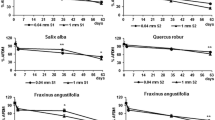Abstract
Decomposition of two species of Salvina, S. molesta Mitchell and S. cucullata Roxb. was studied for 220 days by the litter bag method. Salvinia molesta decomposes faster in the initial stages and S. cucullata in the later stages of decomposition. The release of nutrients is rapid during the first seven days and is ascribed to leaching. The rate of release of nutrients differs in the two species, with higher rates for P, Ca and Mg in S. molesta and for N in S. cucullata.
Similar content being viewed by others
References
Bowmaker, A., 1970. A prospect of lake Kariba. Optima 20: 63–74.
Boyd, C. E., 1970. Losses of mineral nutrients during decomposition of Typha latifolia. Arch. Hydrobiol. 61: 511–517.
Brinson, M. M., 1977. Decomposition and nutrient exchange of litter in alluvial swamp forest. Ecology 58: 601–609.
Davis, C. B. & A. G. Van der Valk, 1978. The decomposition of standing and fallen litter of Typha glauca and Scirpus fluviatilis. Can. J. Bot. 56: 662–675.
Deshpande, J. V., 1943. A study of the sporophyte of Salvinia cucullata. Roxb. J. Ind. bot. Soc. 22: 59–84.
Godshalk, G. L. & R. G. Wetzel, 1978. Decomposition in the littoral zone of lakes. In R. E. Good, D. F. Whigham & R. L. Simpson (eds.), Freshwater Wetlands: Ecological Processes and Management Potential, Academic Press, N.Y.: 131–143.
Gopal, B., 1976. A note on the growth and ecology of Salvinia molesta Mitchell. In C. K. Varshney & J. Rzoska (eds.), Aquatic weeds in S.E. Asia. Dr. W. Junk b.v. Publishers, The Hague, Neth.: 177–181.
Kulshreshtha, M. & B. Gopal, 1982a. Decomposition of freshwater wetland vegetation. 1. Submerged and free floating macrophytes. In B. Gopal, R. E. Turner, R. G. Wetzel & D. F. Whigham (eds.), Wetlands, Ecology and Management Natn. Inst. Ecol. Int. scient. Publs, Jaipur: 259–278.
Kulshreshtha, M. & B. Gopal, 1982b. Decomposition of freshwater wetland vegetation. 2. Aboveground organs of emergent macrophytes. In B. Gopal, R. E. Turner, R. G. Wetzel & D. F. Whigham (eds.), Wetlands, Ecology and Management. Natn. Inst. Ecol. int. Scient. Publs, Jaipur: 279–292.
Laube, H. R. & R. Wholer, 1973. Studies on the decomposition of a duck weed (Lemnaceae) Community. Bull. Torrey hot. Club 100: 238–240.
Mason, C. E. & J. R. Bryant, 1975. Production, nutrient content and decomposition of Phragmites communis Trin. and Typha angustifolia L. J. Ecol. 63: 71–98.
Mitchell, D. S., 1973. Salvinia molesta sp. nov. Br. Fern. Gaz. 10: 251–252.
Mitchell, D. S. (ed.) 1974. Aquatic vegetation and its use and control. Unesco, Paris, 135 pp.
Mitchell, D. S. & P. A. Thomas, 1972. Ecology of water weeds in the neotropics. Int. hydrol. Decade, Tech. Pap. Hydrol., 12, Unesco, Paris.
Olson, J. S., 1963. Energy storage and the balance of producers and decomposersin ecological systems. Ecology 44: 322–331.
Room, P. M., 1983. Falling apart as a lige style. The rhizome architecture and population growth of Salvinia molesta. J. Ecol. 71: 349–366.
Room, P. M. & J. D. Kerr, 1983. Temperature experienced by the floating weed Salvinia molesta and their prediction from meteorological data. Aquat. Bot. 16: 91–104.
Sharma, K. P. & B. Gopal, 1982. Decomposition and nutrient dynamics in Typha elephantina Roxb. under different water regimes. In B. Gopal, R. E. Turner, R. G. Wetzel & D. F. Whigham (eds.), Wetlands, Ecology and Management. Natn. Inst. Ecol. Int. scient. Publs, Jaipur: 321–334.
Toerien, D. F., P. R. Cary, C. M. Finlayson, D. S. Mitchell & P. G. J. Weerts, 1983. Growth models for Salvinia molesta Aquat. Bot. 16: 173–180.
Varshney, C. K. & K. P. Singh, 1976. A survey of aquatic weed problems in India. In C. K. Varshney & J. Rzoska (eds.), Aquatic Weeds in S.E. Asia. Dr. W. Junk b.v. Publishers, The Hague, Neth.: 31–41.
Whigham, D. F. & R. L. Simpson, 1976. The potential use of tidal marshes in the management of water quality in the Delaware river. In J. Tourbie & R. R. Pierson (eds.), Biological control of water pollution. University of Pennsylvania Press, Philad.: 173–186.




